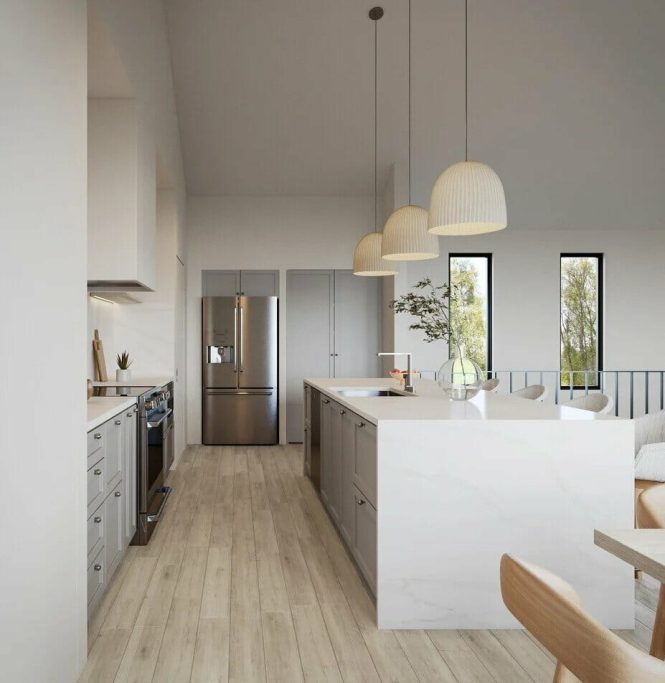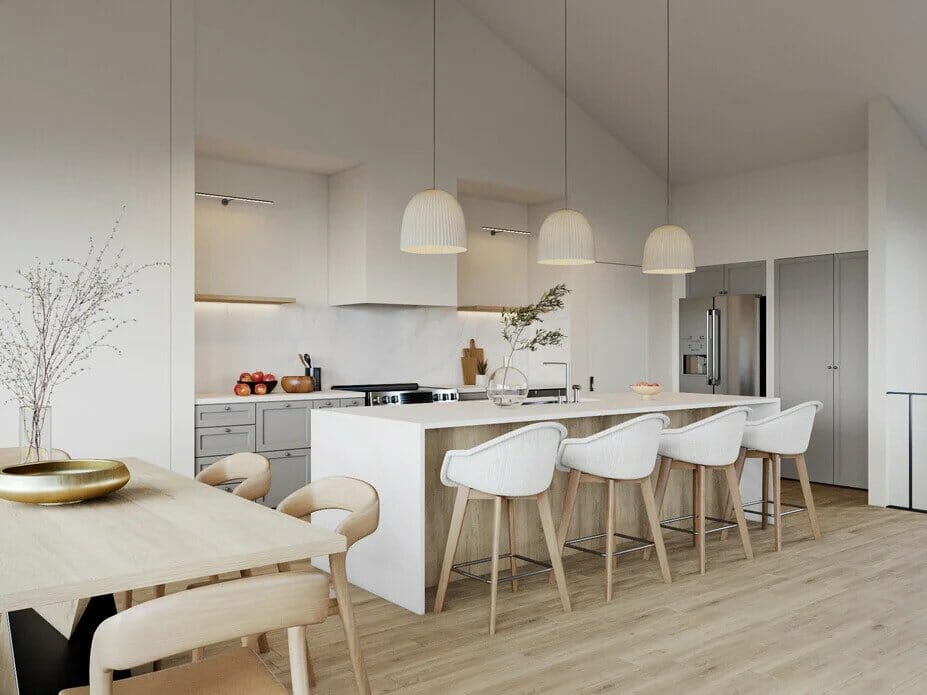

Scandinavian minimalist design is rapidly gaining popularity as a way to create homes that are both beautiful and practical. This design approach, inspired by the minimalist and clean aesthetic of Scandinavian countries, focuses on functionality and warmth. The style often evokes a sense of tranquility and coziness, offering a welcoming atmosphere for residents. Many people desire a living space that exudes tranquility and efficiency but struggle to attain it due to cluttered or poorly arranged spaces, which can be particularly challenging in smaller homes. This article will explore the key elements of Scandinavian minimalist design, showcasing how to create cozy yet functional living spaces. We will explore the core principles, discuss how to incorporate natural elements and color palettes, and offer insightful design ideas, ultimately empowering you to achieve a serene and practical home.
Defining Scandinavian Minimalist Design
Core Principles
Scandinavian minimalist design is more than just a style; it’s a philosophy rooted in functionality and simplicity. This aesthetic champions the use of clean lines, natural materials, and neutral color palettes to create a calming and welcoming atmosphere. The design philosophy prioritizes practicality over ornamentation, focusing on carefully selected furniture and decor. It’s about creating spaces that are visually appealing without sacrificing practicality. The style often promotes a deep appreciation for natural light and spaciousness, thereby contributing to a heightened sense of tranquility. This style often prioritizes the harmonious blending of form and function, leading to designs that are not only beautiful but also very practical for everyday living. Minimalism, in this context, goes beyond simply having few items; it implies a thoughtful approach to every element, selecting pieces that serve a purpose rather than just adding visual clutter.
Examples and Inspirations
Consider homes and apartments in Scandinavian countries like Sweden, Norway, and Denmark. You will frequently find open floor plans, an abundance of natural light, and minimal décor in these spaces. These spaces are typically characterized by light-colored walls, wooden floors, and furniture with clean lines. Natural materials such as wood, stone, and textiles are common features. Designers often incorporate natural materials as ways to foster a connection with nature, further enhancing the sense of tranquility.
The Problem: Unbalanced Spaces
Many people face the challenge of creating functional yet visually appealing living spaces. Overcrowding, mismatched furniture, and excessive décor can quickly turn a home into a chaotic and unwelcoming place. The desire for balance between elegance and simplicity often creates stress for homeowners.
Creating Cozy and Functional Spaces
Natural Elements
An essential aspect of Scandinavian minimalism is the use of natural elements. Wood, stone, and textiles like wool and linen play a crucial role in bringing warmth and texture to the space. Incorporating natural materials creates a link with the outdoors, lending a sense of serenity. For instance, consider a wooden coffee table, a stone-clad fireplace, or a cozy wool blanket draped over a sofa—these simple yet effective touches amplify the space’s connection to nature. Natural light is also central in this style, encouraging an unobstructed flow, promoting a sense of tranquility, and enabling the spaces to feel more welcoming and larger.
Color Palettes
Neutral color palettes are a hallmark of Scandinavian minimalist design. Light grays, creams, whites, and subtle beiges are prevalent, creating a sense of calm and spaciousness. Accenting these neutrals with pops of color through artwork, accessories, or textiles can add personality without overwhelming the space. This harmonious color balance allows the room to feel serene and organized, perfect for relaxation and creativity. The use of neutral color palettes isn’t merely about aesthetics; it also contributes to an atmosphere of tranquility. This tranquil setting can foster a sense of calmness, reducing the feelings of stress that can arise from cluttered spaces.
Furniture Selection and Placement
Essential Furniture
Functional and well-designed furniture is paramount in Scandinavian minimalism. Pieces are chosen based on their utility and aesthetic appeal. Avoid clutter—that is, keep only the items that are absolutely needed. This approach prevents the space from becoming overcrowded. Think about chairs that can serve multiple purposes or beds that can be used as storage. Consider modular sofas that can adapt to space limitations. When choosing furniture, ensure that it blends well with the overall design while maintaining its practicality. This strategic selection ensures a balanced appearance.
Maximizing Space
Open floor plans are common in Scandinavian minimalism, allowing natural light to flood the space, creating a larger, more airy atmosphere. Smart storage solutions are crucial in making the most of a space, especially if it’s a smaller room. Consider utilizing under-bed storage, ottomans with hidden compartments, or tall bookcases that offer both storage and visual interest. These solutions maximize the utilization of space while keeping the appearance of the space neat and uncluttered.
Lighting Design
Natural Light
Natural light is a cornerstone of Scandinavian minimalist design. Maximize natural light by using sheer curtains or blinds to filter light effectively. Keep windows unobstructed to allow maximum light into the space. Maximize the visual appeal of a space by taking advantage of natural light wherever possible; this is a key aspect of Scandinavian design.
Artificial Light
Incorporate a variety of ambient and task lighting to add to the design. Use soft lighting from lamps, strategically placed wall sconces, and pendant lighting to create an inviting and functional lighting scheme. Avoid harsh overhead lighting.
The Importance of Texture
This style encourages adding texture to add visual interest and depth. Incorporate textures through the use of textiles such as throws and cushions, as well as through natural materials like wood and stone. Adding interesting textures through materials like wool and linen can also add warmth and comfort to the space.
Accentuating with Art and Accessories
Minimalist Approach
Artwork and accessories should be carefully selected to complement the overall design. Avoid cluttering the space with too many items—quality over quantity is the motto. Select artwork or accessories that evoke a sense of calm and connection with nature, and that are pieces that are meaningful to you as a way to add your personality to the space. Choose pieces that speak to your individual style.
Color and Pattern
Use pops of color or patterns to add visual interest without disrupting the overall harmony of the space. Employ these color and pattern considerations in ways that create focus and interest without overwhelming the space.
The Role of Personalization
Personal touches are welcome in minimalist spaces, as the design encourages individuality. Use meaningful items to add warmth and personality to the space.
How can I create a cozy atmosphere in a minimalist space?
Adding textures like wool blankets, linen cushions, and natural wood accents can bring warmth to a minimalist space. Incorporating soft lighting, like lamps and string lights, can also contribute to a cozy ambiance. Careful selection of artwork and decorative accessories with personal meaning can further enhance the feeling of coziness.
How do I choose the right furniture for a minimalist living room?
Focus on pieces that serve a purpose and have clean lines. Consider multi-functional furniture like ottomans with storage or modular sofas. Ensure the furniture complements the color palette and overall aesthetic of the space. Opt for pieces made from natural materials like wood or stone.
How can I maximize space in a smaller minimalist apartment?
Utilize space-saving furniture, like storage ottomans or beds with built-in storage. Embrace open floor plans to visually expand the area. Consider incorporating mirrors strategically to reflect light and create an illusion of more space.
How do I balance aesthetics with practicality in a minimalist design?
Prioritize functional and well-designed furniture that aligns with your design aesthetic. Choose pieces that serve a purpose and enhance both the visual appeal and functionality of the space. Carefully consider storage solutions that are both aesthetically pleasing and effective. When choosing furniture or accessories, focus on pieces that enhance the overall look and feel of your living space without compromising its practicality.
Frequently Asked Questions
What are the key elements of Scandinavian minimalist design?
Scandinavian minimalist design is characterized by a focus on functionality, simplicity, and natural elements. Clean lines, natural materials like wood and stone, and neutral color palettes are common features. The design prioritizes maximizing natural light, creating spacious and airy rooms, and carefully choosing furniture for both aesthetic appeal and practicality.
In conclusion, Scandinavian minimalist design offers a pathway to creating cozy and functional living spaces. By prioritizing simplicity, natural elements, and thoughtful design choices, you can achieve a harmonious blend of aesthetics and practicality. Embrace the concept of less is more and incorporate these principles into your next home improvement project or interior design endeavor. Consider browsing online resources or consulting with interior designers for more in-depth exploration. Remember, consistency in your color scheme is key for achieving a truly cohesive aesthetic.